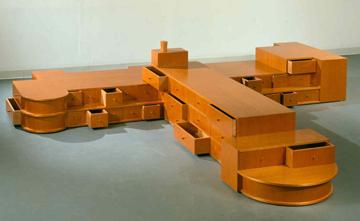Engaging Representations
dal 10/12/2004 al 6/3/2005
Segnalato da
Gerald Giamportone
Tania Kovats
Catherine Yass
Arturo Alonzo
Los Carpinteros
Russel Hulsey
Barbara Kruger
Haim Steinbach
David Levinthal
Cindy Sherman
Vik Muniz
Polly Apfelbaum
Carter Potter
Ghada Amer
Carrie Mae Weems
Lorna Simpson
Louis Zoellar Bickett
Alice Stites
10/12/2004
Engaging Representations
UK Art Museum, Lexington
Contemporary Art from The Speed Art Museum

This selection of works from the collection of Louisville's Speed Art Museum offers a profound and provocative exploration of how the world in which we live today is represented in art. The twenty-three artworks featured include paintings, sculpture, photographs, and a video by nineteen artists from across the globe. Examining a variety of contemporary physical and cultural environments, the exhibition presents a wide range of subject matter, from abstract emanations of land- and cityscapes to incisive social and historical critiques. Engaging Representations also illustrates the influences of art history, the mass media, and the roles these visual agents play in creating meaning and shaping cultural identities.
The exhibition begins with an exploration of the environments in which we live, both physical and cultural. Gerald Giamportone's large-scale photographs suggest aerial views of a barren topography, while Tania Kovats's plinth-encased craters ground the viewer in both the pristine halls of an art gallery and in an imaginary volcanic landscape. The frenetic energy of urban life springs forth from Catherine Yass's lightbox image of a blurred, brightly colored cityscape; the rows of windows and walls and the frenzied intersection of humanity with the constructed urban environment is echoed again in Arturo Alonzo Sandoval's Cityscape #6. The compelling blend of architecture, sculpture, and furniture that characterizes the work of the Cuban artists known as Los Carpinteros suggests the compartmentalization of city dwellers, while also critiquing the bureaucratic vision of twentieth-century urban planners, as well as the ideals of Modernism: Edificio Jerez is a unique and beautifully crafted work, but it is not purely self-referential. All of these representations of our lived environment reveal the complex conceptual construction of our physical world.
Electronic media now dominate the spaces in which we both live and think. Russel Hulsey's video work, Mother, attests to the prevailing lure of television culture, while also requiring the viewer's active participation in deciphering the image he presents. The dangers of passivity and conformity in a media-dominated, consumer culture are powerfully articulated in Barbara Kruger's two silkscreens, while Haim Steinbach's Stay with Friends offers a Pop Art vision of the intersection between art and consumerism. The impact of movies, another great American pastime, is revealed in David Levinthal's dark images of miniature faux movie sets; his work illuminates both the pseudo-glamour of Hollywood and the alienation of urban life.
Allusions to and appropriations from art history animate the works of Cindy Sherman, Vik Muniz, Polly Apfelbaum, and Carter Potter. Sherman casts herself as Madame de Pompadour in a “send-up†critique of both women's roles and eighteenth-century portraiture. Muniz's playful and provocative photographic constructions recycle masterpieces by Théodore Géricault and Caspar David Friederich, while also alluding to Jackson Pollock's paintings. The Abstract Expressionist use of saturated color is also echoed in works by Apfelbaum and Potter, whose film-strip covered canvases reference both Minimalism and Marcel Duchamp's tradition of the readymade: creating art out of everyday, found objects.
Indeed, the addition of found objects with the traditional materials of fine art is a common practice among the artists featured in this exhibition, illustrating the longevity of the Duchampian spirit. The agony of the influence of Minimalism, one of the most defining movements of the twentieth century, is at once celebrated and dissected in works by Potter, Steinbach, Apfelbaum, Giamportone, and many others, attesting to both the power of its aesthetic and to its conceptual vulnerability.
Engaging Representations also examines the construction of historical identity, and the confluence of power, politics, and ritual in creating and preserving cultural legacies. Ghada Amer, Carrie Mae Weems, and Lorna Simpson expose, debunk, and transform stereotypes of gender and race in their poetic and provocative works. Both current and archival images are used in these works to demonstrate the fiction of photography: how photographs, which are so often considered purveyors of truth, create misleading mythologies of history and identity. Weems and Cambodian Din Q Le recycle archival images in order to illuminate and preserve aspects of endangered cultures. Their works, along with Louis Zoellar Bickett's Family Grave Dirt and C.J. Pressma's weave of photographed faces and places in Cuba, demonstrate our need to preserve and memorialize our past and present identity. The powerful desire to illuminate and remember who we were and are is a perplexing one, for, as demonstrated by these artworks, the complexities of individual and cultural identities are as shifting and subjective as the modes of representation used to illustrate them.
By UKAM Guest Curator, Alice Stites
Speed Art Museum Adjunct Curator
Engaging Representations is organized by The Speed Art Museum in Louisville, Kentucky, in coordination with the University of Kentucky Art Museum. This exhibition is made possible by the generous support of the Elizabeth Firestone Graham Foundation and the Friends of the University of Kentucky Art Museum.
Engaging Representations is free and open to the public. A special Artists and Members Preview will be held December 11 from 3 to 5 p.m. in the museum's galleries. This event is free to artists and UK Art Museum members. Please call 859-257-5716 for more information regarding this preview event.
Image: LOS CARPINTEROS (Marco Antonio Castillo Valdes and Dagoberto Rodriguez Sanchez) Edificio Jerez, 2003 Cedar plywood 27 1/2 x 136 1/4 x 131†Gift of the New Art Collectors
The Speed Art Museum
The Museum is located inside the Singletary Center for the Arts on the campus of the University of Kentucky. It is on the corner of Rose Street and Euclid Avenue.



